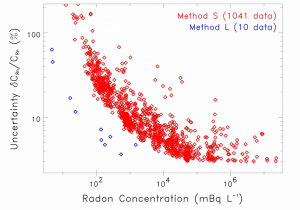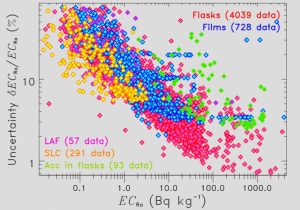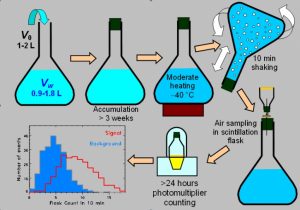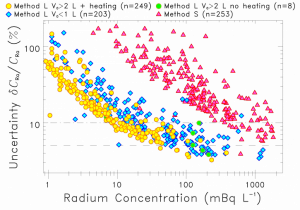Instrumentation of PSN team
Measurement of radon concentration in water
Since 2009, the team is getting experience with two methods to measure activity concentration of radon-222 in water: a fast standard method, in which water is sampled and the concentration obtained a few hours later, and a high-sensitivity method that requires, after water is sampled, a counting session of 24 hours at least, and a preparation of at least 3 days to measure precisely the background count in every instance. More than 1000 measurements of radon concentration in water have been performed before April 2017.
Instruments
Scintillating flasks and CALENTM photomultiplier counters.
Experimental protocol
Water (or the other liquid to measure) must be transferred in a glass container (bottles, Erlenmeyer flasks, flat bottom flasks), leaving a certain quantity of air in the container before closing it with a pre-perforated stopper. For water from a natural spring, 300 mL of water in a 500 mL container is sufficient. When the radon-222 concentration is small (of the order of 50 mBq/L or smaller), it is better to use 1800 mL of water in a 2 L container.
Radon-222 is then partly transferred to the air phase by shaking, then a part of the air is sampled using a scintillating flask, whose alpha activity is then obtained in a photomultiplier counter. The air sampling must be done preferably the day of the water sampling, or no later than three days afterwards.
Details of the methods, systematic effects and validation tests are described in Girault & Perrier (2014) for the standard method and in Perrier et al. (2016) for the high-sensitivity method (see references below).
Experimental uncertainties
Typical uncertainties for the standard method (S) and the high-sensitivity method (L) are given in the graph below:

Applications
The two methods can be used in the laboratory or in the field, even in remote areas with no electricity. These methods so far have concerned almost only radon-222 in water, but the methods apply to any liquid in principle, provided the partition coefficient of radon between air and the given liquid is known as a function of temperature. Tests have been performed with urine, for example.
Contact
Measurements can be carried out on demand. To get a price offer, please get in touch with one team member ( or ), stating the goals and conditions.
Manufacturer of the instruments
Documents
General introduction to radon-222 concentration in water:
Girault, F., F. Perrier, T.A. Przylibski, Radon-222 and radium-226 occurrence in water: A review, In Gillmore, G.K., Perrier, F.E., Crockett, R.G.M. (eds) Radon, Health and Natural Hazards. Geological Society, London, Special Publications, 451, SPA451.3, 2016.
Validation and case examples: The Himalayas of Nepal:
Girault, F., B. Koirala, M. Bhattarai, F. Perrier, Radon and carbon dioxide around remote Himalayan thermal springs, In Gillmore, G.K., Perrier, F.E., Crockett, R.G.M. (eds) Radon, Health and Natural Hazards. Geological Society, London, Special Publications, 451, SPA451.6, 2016.
Girault, F., F. Perrier, The Syabru-Bensi hydrothermal system in central Nepal: 2. Modeling and significance of the radon signature, Journal of Geophysical Research Solid Earth, 119, 4056-4089, 2014.
High-sensitivity method:
Perrier, F., J. Aupiais, F. Girault, T.A. Przylibski, H. Bouquerel, Optimized measurement of radium-226 concentration in liquid samples with radon-222 emanation, Journal of Environmental Radioactivity, 157, 52-59, 2016.
Hygrometry and evaporimetry
Measurement of carbon dioxide flux
Measurement of effective radium in rocks and soils
Measurement of effective radium-226 concentration in solid materials
Several methods have been practised since 2007 to measure the radon emanation potential of solid materials. This emanation power is now referred to as effective radium-226 concentration, ECRa, product of radium-226 activity concentration CRa and of the emanation coefficient E, probability that a radium-226 atom emits a radon-222 atom in the pore space. Effective radium concentration is expressed in Bq/kg.
Instruments
Scintillating flasks and CALENTM photomultiplier counters. DOSIRAD or ALGADE films. AlphaGUARDTM, BarasolsTM, and CANARYTM recorders.
Experimental protocols
The measurement of ECRa is based on accumulation experiments: the material to be measured is enclosed in an airtight container and the increase of radon-222 concentration in the air volume of the container is measured as a function of time. For this purpose, continuous measurements using recorders such as AlphaguardTM, BarasolsTM and CANARYTM, or intermittent measurements using scintillating flasks are done. Alternatively, integrating devices such as films can be used. All these various methods are practiced in our laboratory. To treat large quantities of samples, one method, referred to as our standard method, has been developed using scintillating flasks. Based on more than 13,000 accumulation experiments, several thousands of samples have been measured before April 2017: more than 1500 rocks, more than 1300 topsoils, and more than 500 sediments. After 2015, two high-sensitivity methods (LAF and SLC) were developed, which cannot measure that many samples, but which allow measuring samples of a few grams and sometimes as small as one gram (biological samples, meteorites, single crystals, etc…).
Experimental uncertainties
Typical uncertainties for the various methods (Flasks, Films, Accumulation in flask) and high-sensitivity methods (LAF, SLC) are given in the following graph:

Applications
Examples of applications have been demonstrated in various fields: geological mapping, sedimentology, characterisation of hydrothermal systems, environmental problems (polluted sites) or transfer of radionuclides to the biosphere (see documents referenced below). Several other novel investigations are under way.
Contact
Measurements can be carried out on demand. With the standard method, large quantities of samples can be handled without difficulty routinely (100 samples, 100 g per sample). When quantities are small (1 to 10 grams), it is necessary to use the high-sensitivity methods which require more care and efforts. To get a price offer, please get in touch with one team member ( or ), stating the goals and conditions.
Manufacturers of the instruments
Documents
General introduction on the measurement of radium-226 concentration (standard method):
Perrier, F., F. Girault, H. Bouquerel, Effective radium-226 concentration in rocks, soils, plants, and bones, In Gillmore, G.K., Perrier, F.E., Crockett, R.G.M. (eds) Radon, Health and Natural Hazards. Geological Society, London, Special Publications, 451, SPA451.8, 2016.
Girault, F., F. Perrier, Measuring effective radium concentration with large numbers of samples Part II – General properties and representativity, Journal of Environmental Radioactivity, 113, 189-202, 2012.
Girault, F., F. Perrier, Measuring effective radium concentration with large numbers of samples Part I – Experimental method and uncertainties, Journal of Environmental Radioactivity, 113, 177-188, 2012.
Perrier, F., F. Girault, Measuring effective radium concentration with less than 5 g of rock or soil, Journal of Environmental Radioactivity, 113, 45-56, 2012.
Girault, F., F. Perrier, Heterogeneous temperature sensitivity of effective radium concentration from various rock and soil samples, Natural Hazards and Earth System Sciences, 11, 1619-1626, 2011.
Relationship to magnetic susceptibility and application to polluted sites:
Girault, F., F. Perrier, C. Poitou, A. Isambert, H. Théveniaut, V. Laperche, B. Clozel-Leloup, F. Douay, Effective radium concentration in topsoils contaminated by lead and zinc smelters, Science of the Total Environment, 566-567, 865-876, 2016.
Girault, F., C. Poitou, F. Perrier, B.P. Koirala, M. Bhattarai, Soil characterization using patterns of magnetic susceptibility versus effective radium concentration, Natural Hazards and Earth System Sciences, 11, 2285-2293, 2011.
Application to the characterisation of soils and sediments:
Perrier, F., F. Girault, H. Bouquerel, L. Bollinger, Effective radium concentration in agricultural versus forest topsoils, Journal of Environmental Radioactivity, 160, 123-134, 2016.
Girault, F., A.P. Gajurel, F. Perrier, B.N. Upreti, P. Richon, Radon emanation of heterogeneous basin deposits in Kathmandu Valley, Nepal, Journal of Asian Earth Sciences, 40, 595-610, 2011.
Geophysical and geological applications in the Himalayas:
Girault, F., F. Perrier, The Syabru-Bensi hydrothermal system in central Nepal: 2. Modeling and significance of the radon signature, Journal of Geophysical Research Solid Earth, 119, 4056-4089, 2014.
Girault, F., F. Perrier, R. Crockett, M. Bhattarai, B.P. Koirala, C. France-Lanord, P. Agrinier, M. Ader, F. Fluteau, C. Gréau, M. Moreira, The Syabru-Bensi hydrothermal system in central Nepal: 1. Characterization of carbon dioxide and radon fluxes, Journal of Geophysical Research Solid Earth, 119, 4017-4055, 2014.
Girault, F., F. Perrier, A.P. Gajurel, B.P. Koirala, M. Bhattarai, L. Bollinger, M. Fort, C. France-Lanord, Effective radium concentration across the Main Central Thrust in the Nepal Himalayas, Geochimica et Cosmochimica Acta, 98, 203-227, 2012.
High-sensitivity methods and application to extra-terrestrial samples:
Girault, F., F. Perrier, M. Moreira, B. Zanda, P. Rochette, Y. Teitler, Effective radium-226 concentration in meteorites, Geochimica et Cosmochimica Acta, 208, 198-219, 2017.
Measurement of radium concentration in water
Measurement of radium-226 in water
Since 2009, two methods are experimented to measure radium-226 concentration activity in water: a standard method, in which the concentration is obtained a few hours after air sampling, and one high-sensitivity method that requires a counting session of 24 hours at least, and a preparation of at least 3 days to measure precisely the background count in every instance. In both methods, the measurement by radon emanometry requires a prior accumulation time of the container, with the liquid to be measured, of duration larger than one month, more if the initial radon-222 concentration is high. More than 820 measurements of radium-226 in water have been performed before April 2017.

Instruments
Scintillating flasks and CALENTM photomultiplier counters.
Experimental protocol
Water (or the other liquid to measure) must be transferred in a glass container (bottles, Erlenmeyer flasks, flat bottom flasks), leaving a certain quantity of air in the container before closing it with a pre-perforated stopper. For water from a natural spring, 800 mL of water in a 1 L container is sufficient. When the radium-226 concentration is small (of the order of 50 mBq/L or smaller, which is frequent for natural surface waters), it is better to use 1800 mL of water in a 2 L container. The container must then be stored for a sufficiently long time so that all initially present radon-222 will disintegrate, at least one month, and sometimes longer than three months if the initial radon-222 concentration is larger than 500 Bq/L, which is frequently the case in granitic areas and for some geothermal systems. After this equilibration time, the remaining radon-222 in the container is in radioactive equilibrium with the radium-226 contained in the liquid.
The measurement consists, as in the case of radon-222, in establishing chemical equilibrium between the air and the liquid phase by shaking, followed by sampling of the air using a scintillating flask. In the case of radium-226, by contrast with radon-222 comparatively easy to measure, it is often necessary to use the high-sensitivity method. Generally, the container is mildly heated (40 °C) to improve the detection limit.
Details of the methods, systematic effects and validation tests are described in Girault & Perrier (2014) for the standard method and in Perrier et al. (2016) for the high-sensitivity method (see references below).
Experimental uncertainties
Typical uncertainties for the standard method (S) and the high-sensitivity method (L) are given in the graph below, separating measurements with container of volume <1 L, from those of volume >2 L, with and without heating:

Applications
Given the fact that radium-226 concentrations are generally small and need to be measured with care, these two methods are generally used in the laboratory. However, they can also be applied in the field when the conditions are adequate, even in remote areas without electricity. The methods have mostly been applied so far for radium concentration in water, but the methods apply to any liquid in principle, provided the partition coefficient of radon between air and the given liquid is known as a function of temperature. Tests have been performed with sodas, coke, wine, etc…
Contact
Measurements can be carried out on demand. To get a price offer, please get in touch with one team member ( or ), stating the goals and conditions.
Manufacturer of the instruments
Documents
General introduction on radium-226 concentration in water:
Girault, F., F. Perrier, T.A. Przylibski, Radon-222 and radium-226 occurrence in water: A review, In Gillmore, G.K., Perrier, F.E., Crockett, R.G.M. (eds) Radon, Health and Natural Hazards. Geological Society, London, Special Publications, 451, SPA451.3, 2016.
Validations and examples of results: case of the Himalayas of Nepal:
Girault, F., B.P. Koirala, M. Bhattarai, F. Perrier, Radon and carbon dioxide around remote Himalayan thermal springs, In Gillmore, G.K., Perrier, F.E., Crockett, R.G.M. (eds) Radon, Health and Natural Hazards. Geological Society, London, Special Publications, 451, SPA451.6, 2016.
Girault, F., F. Perrier, The Syabru-Bensi hydrothermal system in central Nepal: 2. Modeling and significance of the radon signature, Journal of Geophysical Research Solid Earth, 119, 4056-4089, 2014.
High-sensitivity method, tests and applications:
Perrier, F., J. Aupiais, F. Girault, T.A. Przylibski, H. Bouquerel, Optimized measurement of radium-226 concentration in liquid samples with radon-222 emanation, Journal of Environmental Radioactivity, 157, 52-59, 2016.
Measurement of radon concentration in air
Measurement of radon-222 concentration in air
We have experience in our team, since 1998, with several methods to measure radon-222 concentration in air, depending on the context or considered problems: intermittent measurements with scintillating flasks (in situ or using sampling bottles), integrating methods using films, continuous recordings using BARASOLTM, AlphaGUARDTM or CANARYTM recorders.
Experimental protocols
Sampling or installation protocols are different for each method (see the documents referenced below).
Instruments
Mainly scintillating flasks and CALENTM photomultipliers, and BarasolsTM recorders. Occasionally DOSIRAD or ALGADE films, and AlphaGUARDTM and CANARYTM recorders.
Applications
There are numerous applications of the measurement of radon concentration in air: radioprotection, underground atmospheres, underground microclimatology, monitoring of geodynamically active sites (faults, volcanoes), polluted sites, vadose zone, Critical Zone, hydrogeology.
Contact
Measurements and contracts can be carried out on demand. In the case of continuous monitoring, actions take place mostly in the framework of common research programs. To get a price offer, please get in touch with one team member ( or ), stating the goals and conditions.
Manufacturers of the instruments
Documents
Applications in active tectonics:
Girault, F., F. Perrier, The Syabru-Bensi hydrothermal system in central Nepal: 2. Modeling and significance of the radon signature, Journal of Geophysical Research Solid Earth, 119, 4056-4089, 2014.
Richon, P., F. Perrier, B.P. Koirala, F. Girault, M. Bhattarai, S.N. Sapkota, Temporal signatures of advective versus diffusive radon transport at a geothermal zone in Central Nepal, Journal of Environmental Radioactivity, 102, 88-102, 2011.
Data treatment and analysis of time-series:
Crockett, R.G.M., F. Perrier, P. Richon, Spectral-decomposition techniques for the identification of periodic and anomalous phenomena in radon time-series, Natural Hazards and Earth System Sciences, 10, 559-564, 2010.
Dynamics of underground atmosphere:
Perrier, F., P. Richon, Spatiotemporal variation of radon and carbon dioxide concentrations in an underground quarry: Coupled processes of natural ventilation, barometric pumping and internal mixing, Journal of Environmental Radioactivity, 101, 279-296, 2010.
Richon, P., F. Perrier, E. Pili, J.-C. Sabroux, Detectability and significance of 12 hr barometric tide in radon-222 signal, dripwater flow rate, air temperature and carbon dioxide concentration in an underground tunnel, Geophysical Journal International, 176, 683-694, 2009.
Perrier, F., P. Richon, U. Gautam, D. R. Tiwari, P. Shrestha, S.N. Sapkota, Seasonal variations of natural ventilation and radon-222 exhalation flux in a slightly rising dead-end tunnel, Journal of Environmental Radioactivity, 97, 220-235, 2007.
Perrier, F., P. Richon, J.-C. Sabroux, Modelling the effect of air exchange on radon-222 and its progeny concentration in a tunnel atmosphere, The Science of the Total Environment, 350, 136-150, 2005.
Richon, P., F. Perrier, J.-C. Sabroux, M. Trique, C. Ferry, V. Voisin, E. Pili, Spatial and time variations of radon-222 concentration in the atmosphere of a dead-end horizontal tunnel, Journal of Environmental Radioactivity, 78(2), 179-198, 2005.
Perrier, F., P. Richon, C. Crouzeix, P. Morat, J.-L. Le Mouël, Radon-222 signatures of natural ventilation regimes in an underground quarry, Journal of Environmental Radioactivity, 71, 17-32, 2004.
Trique, M., P. Richon, F. Perrier, J.-P. Avouac, J.-C. Sabroux, Radon emanation and electric potential variations associated with transient deformation near reservoir lakes, Nature, 399, 137-141, 1999.
Environmental problems and underground water circulation:
Perrier, F., P. Richon, J.-C. Sabroux, Temporal variations of radon concentration in the saturated soil of Alpine grassland: The role of groundwater flow, Science of the Total Environment, 407, 2361-2371, 2009.
Applications in the laboratory and rock physics:
Girault, F., A. Schubnel, E. Pili, Transient radon signals driven by fluid pressure pulse, micro-crack closure, and failure during granite deformation experiments. Earth and Planetary Science Letters, 474, 409-418, 2017.
Nicolas, A., F. Girault, A. Schubnel, E. Pili, F. Passelègue, J. Fortin, D. Deldicque, Radon emanation from brittle fracturing in granites under upper crustal conditions, Geophysical Research Letters, 41, 5436-5443, 2014.
Measurement of radon flux
Measurement of Self Potential
In detail



